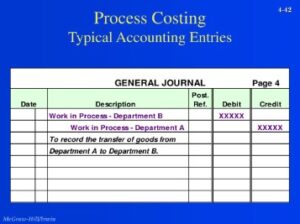The Importance of Trial Balance for Business Owners
Content
This ensures that your books are correct and that you can withstand a financial audit. A trial balance examines whether posting and other accounting processes have been carried out without committing arithmetical errors. Balance brought down (i.e. bal b/d) and balance carried down (bal c/d) are two but different transactions. The difference https://kelleysbookkeeping.com/ between the two is that when preparing the trial balance, it is the balance brought down (bal b/d) which matters. Finally, if some adjusting entries were entered, it must be reflected on a trial balance. In this case, it should show the figures before the adjustment, the adjusting entry, and the balances after the adjustment.

Transferring information from T-accounts to the trial balance
requires consideration of the final balance in each account. If the
final balance in the ledger account (T-account) is a debit balance,
you will record the total in the left column of the trial balance. If the final balance in the ledger account (T-account) is a credit
balance, you will record the total in the right column.
Importance of Accounting Software in Maintaining Trial Balance
But if they’re offset with another mistake that balances the total debit and credit (such as those entered into the wrong accounts) – it is unlikely to be picked up, as the trial balance will still show zero. So, you can’t rely on a trial balance to reveal every issue in your business accounts. That’s why accurate recording is very crucial Preparing A Trial Balance For Your Business and perhaps checking your trial balance regularly until you’re able to nail down your processes. A trial balance is to confirm that all recorded debits and credits are correct. It also serves as a review stage to point out discrepancies and rectify them. It’s usually the first stage of preparing official financial records and statements.
- You need to refer back to your general ledger to determine where the error is.
- If the debit column were larger, this would mean the expenses were larger than revenues, leading to a net loss.
- The Trial Balance Worksheet contained in the attached file is designed to save you time and money in preparing the trial balance yourself.
- While we still have not prepared financial statements, we have captured the activity and organized it into a trial balance.
- For example, let’s say that you bought $600 worth of office supplies on a personal credit card, resulting in a $600 credit excess on your unadjusted trial balance.
Editorial content from The Ascent is separate from The Motley Fool editorial content and is created by a different analyst team. If you want to build on the skills and knowledge gained from studying this course, you might be interested in taking the Open University course B124 Fundamentals of accounting. Making the decision to study can be a big step, which is why you’ll want a trusted University.
Invest in accounting software
It helps in referring to the ledger only during the requirement of more details in respect of an account. When preparing the trial balance, the balance brought down (bal b/d) is the one considered. Such that if the balance is a DR balance b/d, it is recorded on the DR side of the trial balance. On the other hand, if the balance brought down (bal b/d) is a CR balance, it is recorded on the CR side of the trial balance. So the question is, what should one do when he or she overdraws from his bank account? Instead, the cashbook, the bank column is the tool that represent such a transaction.
- The main purpose of a trial balance is to ensure that bookkeeping entries are correct.
- This free course, Fundamentals of accounting, has introduced you to the essential concepts and skills of accounting in four interactive weeks of study.
- Thus, when a difference is divisible by 9, compare the trial balance amounts with the general ledger account balances to see if you made a transposition or slide error in transferring the amounts.
- So the cost of the computer ($1000) will go into the credit balance as a purchase (- $1000) and then into the debit balance too because it is a new asset for your company (+ $1000).
- It’s worth noting that a trial balance differs from a balance sheet, as the latter is something that is distributed outside of the accounting team, and sometimes the business.
Each month, you prepare a
trial balance showing your company’s position. After preparing your
trial balance this month, you discover that it does not balance. The debit column shows $2,000 more dollars than the credit column. Balance sheets are commonly prepared in a vertical format of the accounting equation.
Income Statement
An adjusted trial balance is an internal document that summarizes all of the current balances available in general ledger accounting. The adjusted trial balance is prepared to show updated balances after adjusting entries have been made. The trial balance does not list each transaction your business made under the accounts. Instead, it shows each account’s total debit and credit balances. Business owners prepare a trial balance more than once during the accounting cycle. In fact, you need to use three trial balances when closing your books—one for three different stages in the cycle.
However, trial balances are still useful for accountants who need to check their work and for auditors who may need to understand which accounts to audit. The first step toward interpreting the financial results of your business is preparing a trial balance report. Both the unadjusted trial balance and the adjusted trial balance play an important role in ensuring that all of your accounts are in balance and financial statements will reflect the most accurate totals.
